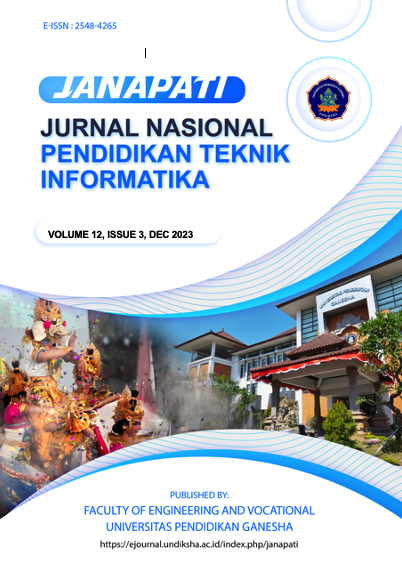Implementation of Virtual Reality Museum Lontar Prasi Bali As a Cultural Education Media
DOI:
https://doi.org/10.23887/janapati.v12i3.69620Keywords:
Virtual Reality, Lontar Prasi, Museum, CulturalAbstract
Lontar Prasi Bali is famous for its distinctive paintings on palm leaves, a cultural heritage that must be preserved and continued. Main problem occurred because 82.5% of 189 respondents consisting of elementary school students in Denpasar Selatan stated that they did not know about Lontar Prasi Bali. The aim of collecting data from elementary school student respondents is to increase insight into Lontar Prasi and the target of this research is to introduce VR-based lontar prasi culture to children, especially elementary school students. There needs to be collaboration between culture and technology so that people understand the story and provide education about Lontar Prasi Bali, one of which is by implementing VR. The design method used is MDLC Multimedia Development Life Cycle (MDLC) which consists of concept, design, material collection, assembly, testing and distribution. The results of research using Likert scale stated that the use of VR showed that 84.75% of respondents stated Strongly Agree with the Lontar Prasi Museum Virtual Reality Application.
References
I. Akbar Endarto, “Analisis Potensi Implementasi Metaverse Pada Media Edukasi Interaktif,” Jurnal Barik, Vol. 4, No. 1, Pp. 37–51, 2022, [Online]. Available: Https://Ejournal.Unesa.Ac.Id/Index.Php/Jdkv/
I. G. I. Sudipa, P. W. Aditama, And C. P. Yanti, “Developing Augmented Reality Lontar Prasi Bali As An E-Learning Material To Preserve Balinese Culture,” J Wirel Mob Netw Ubiquitous Comput Dependable Appl, Vol. 13, No. 4, Pp. 169–181, Dec. 2022, Doi: 10.58346/Jowua.2022.I4.011.
I Gede Iwan Sudipa, Putu Wirayudi Aditama, And Christina Purnama Yanti, “Evaluation Of Lontar Prasi Bali Application Based On Augmented Reality Using User Experience Questionnaire,” East Asian Journal Of Multidisciplinary Research, Vol. 1, No. 9, Pp. 1845–1854, Oct. 2022, Doi: 10.55927/Eajmr.V1i9.1531.
P. Wirayudi, P. Wirayudi Aditama, I. Gede Iwan Sudipa, And C. Purnama Yanti Pusat Studi Digitalisasi Budaya Bali, “Indigenous Bali Of Lontar Prasi Using Augmented Reality For Support Strengthen Local Cultural Content,” Eduvest-Journal Of Universal Studies, Vol. 2, No. 11, 2022, [Online]. Available: Http://Eduvest.Greenvest.Co.Id
T. N. Fitria, “Augmented Reality (Ar) And Virtual Reality (Vr) Technology In Education: Media Of Teaching And Learning: A Review,” 2023. [Online]. Available: Https://Ijcis.Net/Index.Php/Ijcis/Indexjournalijcishomepage-Https://Ijcis.Net/Index.Php/Ijcis/Index
Z. Zulherman*, G. Amirulloh, A. Purnomo, G. B. Aji, And S. Supriansyah, “Development Of Android-Based Millealab Virtual Reality Media In Natural Science Learning,” Jurnal Pendidikan Sains Indonesia, Vol. 9, No. 1, Pp. 1–10, Jan. 2021, Doi: 10.24815/Jpsi.V9i1.18218.
“Summary For Policymakers,” In Climate Change 2013 – The Physical Science Basis, Cambridge University Press, 2017, Pp. 1–30. Doi: 10.1017/Cbo9781107415324.004.
C. Purnama Yanti And S. Ika Murpratiwi, “Pengembangan Augmented Reality Interaktif Untuk Pengenalan Jajanan Tradisional Bali Dengan Marker Based Tracking,” Vol. 6, No. 2, Pp. 2622–4615, 2021, Doi: 10.32493/Informatika.V6i2.12084.
D. Buhalis And N. Karatay, “Mixed Reality (Mr) For Generation Z In Cultural Heritage Tourism Towards Metaverse,” In Information And Communication Technologies In Tourism 2022, Cham: Springer International Publishing, 2022, Pp. 16–27. Doi: 10.1007/978-3-030-94751-4_2.
M. Zallio And P. J. Clarkson, “Designing The Metaverse: A Study On Inclusion, Diversity, Equity, Accessibility And Safety For Digital Immersive Environments,” Telematics And Informatics, Vol. 75, P. 101909, Dec. 2022, Doi: 10.1016/J.Tele.2022.101909.
D. Rama Aulia, “Penerapan Teknologi Virtual Reality Pada Simulasi Sistem E-Ticketing Di Stasiun Kereta Api Bogor,” 2019.
H. A. Musril, J. Jasmienti, And M. Hurrahman, “Implementasi Teknologi Virtual Reality Pada Media Pembelajaran Perakitan Komputer,” Jurnal Nasional Pendidikan Teknik Informatika (Janapati), Vol. 9, No. 1, P. 83, Apr. 2020, Doi: 10.23887/Janapati.V9i1.23215.
M. M. North And S. M. North, “Virtual Reality Therapy,” In Computer-Assisted And Web-Based Innovations In Psychology, Special Education, And Health, Elsevier, 2016, Pp. 141–156. Doi: 10.1016/B978-0-12-802075-3.00006-1.
S. Yang, “Storytelling And User Experience In The Cultural Metaverse,” Heliyon, Vol. 9, No. 4, P. E14759, Apr. 2023, Doi: 10.1016/J.Heliyon.2023.E14759.
M. Afique Bin Mohamed Aziyen And E. Musa Ahmed, “Determinants Of Blender 3d (Open Source) Usage In Malaysian Animation Industry,” 2020.
A. O. Bebko And N. F. Troje, “Design And Control Of Experiments In Virtual Reality And Beyond,” Iperception, Vol. 11, No. 4, Jul. 2020, Doi: 10.1177/2041669520938400.
F. N. Kumala, A. Ghufron, P. P. Astuti, M. Crismonika, M. N. Hudha, And C. I. R. Nita, “Mdlc Model For Developing Multimedia E-Learning On Energy Concept For Primary School Students,” J Phys Conf Ser, Vol. 1869, No. 1, P. 012068, Apr. 2021, Doi: 10.1088/1742-6596/1869/1/012068.
Y. Wilve, B. Woda, I. Dua Reja, And G. G. Rizky, “Application Of The Multimedia Development Life Cycle Method For The Development Of Android-Based E-Learning As An Alternative Learning Media During The Covid-19 Pandemic,” 2022, [Online]. Available: Http://Infor.Seaninstitute.Org/Index.Php/Infokum/Index
P. Studi Manajemen Informatika Politeknik Palcomtech, J. Basuki Rahmat No, And B. Palembang, “Rancang Bangun Aplikasi Sumsel Museum Berbasis Mobile Menggunakan Metode Pengembangan Multimedia Development Life Cycle (MDLC),” vol. 8, no. 1, 2018.
Supriyono, “Software Testing with the approach of Blackbox Testing on the Academic Information System,” International Journal of Information System & Technology, 2020.
Downloads
Published
How to Cite
Issue
Section
License
Copyright (c) 2024 wirayudi aditama wirayudi, Christina Purnama Yanti Christina, I Gede Iwan Sudipa Iwan

This work is licensed under a Creative Commons Attribution-ShareAlike 4.0 International License.
Authors who publish with Janapati agree to the following terms:- Authors retain copyright and grant the journal the right of first publication with the work simultaneously licensed under a Creative Commons Attribution License (CC BY-SA 4.0) that allows others to share the work with an acknowledgment of the work's authorship and initial publication in this journal
- Authors are able to enter into separate, additional contractual arrangements for the non-exclusive distribution of the journal's published version of the work (e.g., post it to an institutional repository or publish it in a book), with an acknowledgment of its initial publication in this journal.
- Authors are permitted and encouraged to post their work online (e.g., in institutional repositories or on their website) prior to and during the submission process, as it can lead to productive exchanges, as well as earlier and greater citation of published work. (See The Effect of Open Access)







